For PC gamers, there isn’t a more important component than a graphics card, but it can be tough to find the best graphics card for you. GPU reviews don’t always tell the full story, and tracking down the graphics card that offers the best value between cost and performance isn’t as simple as shopping online.
We dug through our graphics card reviews to bring you a definitive ranking of the best GPUs for gaming. The competitiveness between AMD and Nvidia is hotter than it has been in years, and we have several options from both brands. If you’re new to building PCs, make sure to read our answers to common GPU questions. We also have a full guide on how to install a graphics card so you can upgrade your PC.










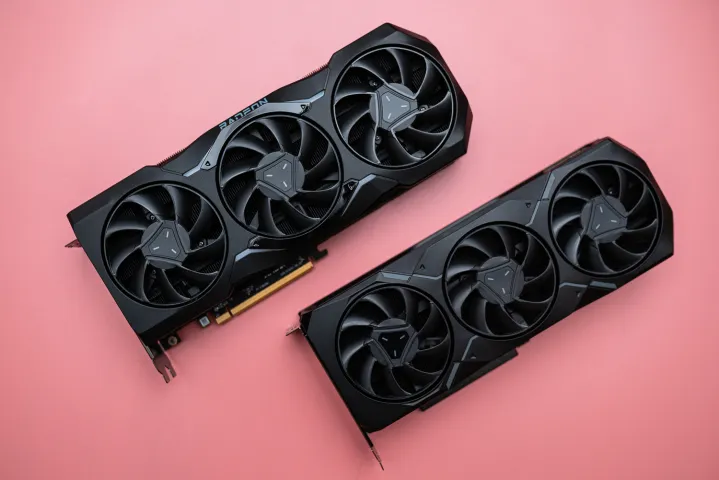
Jacob Roach / Digital Trends
AMD Radeon RX 7900 XTX
The best graphics card for gaming
Pros
- Fantastic value for the RX 7900 XTX
- Playable ray tracing performance
- High refresh rate 4K gaming
- Standard 8-pin power
Cons
- Disappointing generational improvements
- Loud and hot
Why should you buy this: It offers some of the best 4K gaming performance you can find today, and at a reasonable price.
Who’s it for: High-end gamers who need high frame rates, but don’t care much about ray tracing.
What we thought of the AMD Radeon RX 7900 XTX:
The lineup of current-gen GPUs all have one thing in common: they’re expensive. That makes choosing the best GPU tough, but AMD has a compelling offer this time around. The RX 7900 XTX offers flagship performance at an excellent value amid the inflated landscape of GPU prices right now.
For raw performance, the RX 7900 XTX is capable of running the most demanding PC above 60 frames per second (fps), and in the case of titles like Red Dead Redemption 2 and Horizon Zero Dawn, it can even hit around 100 fps. It can go toe-to-toe with Nvidia’s RTX 4080, all while costing anywhere from $200 to $400 less.
In addition, it’s smaller, and it calls for standard 8-pin power rather than the 12-pin connector featured on Nvidia’s most recent GPUs. That doesn’t mean the RX 7900 XTX is without faults. It gets loud and it runs hot and compared to Nvidia, it lacks prowess in ray tracing games.
Even with those caveats, the RX 7900 XTX is an excellent graphics card that can power high-end gaming in demanding titles like Cyberpunk 2077.

AMD Radeon RX 7900 XTX
The best graphics card for gaming

Jacob Roach / Digital Trends
Nvidia GeForce RTX 4070 Super
The best graphics card for 1440p gaming
Pros
- Solid performance improvement over RTX 4070
- Still highly efficient
- DLSS 3.5
- Fantastic ray tracing performance
- Great value
Cons
- Only minor uplifts in a few games
- 12GB of VRAM may limit some ray-traced titles at 4K
Why should you buy this: It’s much faster than the original model, and it comes in at the same price.
Who’s it for: Midrange to high-end gamers looking for a GPU that can handle the most demanding games at 1440p.
What we thought of the Nvidia GeForce RTX 4070 Super:
The RTX 4070 was already a great graphics card, but Nvidia made it even better with a Super refresh. This new version is between 10% and 15% faster than the base model based on our testing, and it still comes with all of the features that made the original version so impressive.
Now, you’re getting frame rates at the target resolution that are consistently above 100 fps, and often much more. On top of that the RTX 4070 Super has enough power to press up to 4K, assuming you make a few compromises in the most demanding games. It’s the Swiss Army Knife of graphics cards, filling its duty as a gaming workhorse in just about any situation.
It comes with Nvidia’s excellent DLSS 3.5, as well. It’s a huge asset in games like Alan Wake 2 with path tracing turned on, and it can make demanding games more playable at 4K. Between DLSS 3, solid raw performance, and an attainable price, the RTX 4070 Super nails a sweet spot that most graphics cards miss.

Nvidia GeForce RTX 4070 Super
The best graphics card for 1440p gaming

Jacob Roach / Digital Trends
Nvidia GeForce RTX 4080
The best graphics card for 4K gaming
Pros
- Excellent power efficiency
- Fantastic 4K performance
- DLSS 3 support
- Solid ray tracing performance
Cons
- Large and bulky
- Not as good of a value as the RTX 4090
Why should you buy this: The RTX 4080 is expensive, but it feels tailor-made for 4K gaming.
Who’s it for: 4K gamers who need above 60 fps in the most demanding games.
What we thought of the Nvidia RTX 4080:
The RTX 4080 is too expensive for what it is, but it’s still a highly capable 4K GPU. Below the price of the monstrous RTX 4090, the cheaper RTX 4080 still delivers high frame rates at 4K, even in demanding games like Cyberpunk 2077.
Although the RTX 4080 isn’t quite as powerful as the RTX 4090, features like DLSS 3 help fill in the gap. That makes ray tracing possible at 4K, even at high frame rates. DLSS isn’t new, but the addition of frame generation on the RTX 4080 can massively boost your frame rate in demanding titles.
The card is big and bulky, but unlike the RTX 4090, it doesn’t require a ton of power. It stays at the same wattage as the previous generation, and in real-world use, it actually consumes about 50W less.
For video editing, it’s tough to beat the RTX 4080. Although there are better value options for gaming, Nvidia still has a massive lead in video editing, and it accelerated tasks in apps like Adobe After Effects and DaVinci Resolve in a way that AMD graphics cards just can’t.

Nvidia GeForce RTX 4080
The best graphics card for 4K gaming

Jacob Roach / Digital Trends
Nvidia GeForce RTX 3060 Ti
The best graphics card under $500
Pros
- Fantastic cost-to-performance ratio at MSRP
- Great for 1440p gaming
- Close to the RTX 3070, but cheaper
Cons
- Not the best option for 4K
Why should you buy this: The RTX 3060 Ti punches well above its weight class.
Who’s it for: 1440p gamers who want all of the visual bells and whistles.
What we thought of the Nvidia GeForce RTX 3060 Ti:
The RTX 3060 Ti is an extremely powerful graphics card, considering its spot in Nvidia’s Ampere gaming lineup. Below the RTX 3070, the 3060 Ti still delivers 8GB of GDDR6 memory on a 256-bit bus and features only a slight reduction in clock speed — 1.67GHz on the 3060 Ti versus 1.72GHz on the 3070. It’s best suited for 1440p gamers that want high frame rates without the high price.
In benchmarks, the RTX 3060 Ti scores above last gen’s GeForce RTX 2080 Super. The card can deliver above 70 fps in demanding titles like Red Dead Redemption 2 with Ultra settings at 1440p. In games like Control, you can take advantage of features like DLSS to boost your performance, too.
The RTX 3060 Ti shines as the best graphics card for 1440p. It’s incredibly capable, offering frame rates north of 60 fps in demanding AAA titles, even with all the sliders turned up. Ray tracing would normally be a problem for a card like this, but thanks to DLSS, you can still hit performance marks with all the visual bells and whistles.

Nvidia GeForce RTX 3060 Ti
The best graphics card under $500
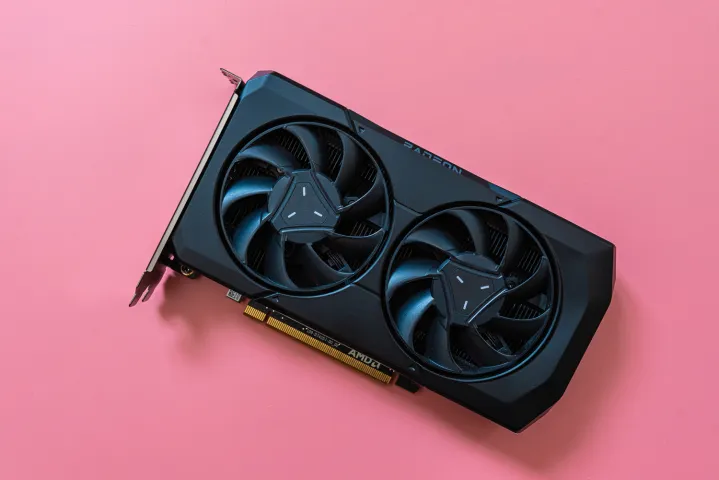
Jacob Roach / Digital Trends
AMD Radeon RX 7600
The best graphics card under $300
Pros
- Solid 1080p gaming performance
- Aggressive pricing
- Only a single 8-pin power connector
- Compact design
Cons
- Memory interface limits higher resolutions
- Ray tracing performance is lacking
Why should you buy this: It’s a solid 1080p graphics card at a reasonable price.
Who’s it for: 1080p gamers on a tight budget.
What we thought of the AMD Radeon RX 7600:
The RX 7600 isn’t a showstopper graphics card, but it’s the closest we’ve seen to a true budget offering this generation. Arriving art $270, the GPU offers above 60 fps in demanding titles like Cyberpunk 2077 at 1080p.
That’s what you want out of a graphics card under $300. The RX 7600 manages to meet, and often exceed, the 60 fps mark for demanding titles at 1080p. It also supports AMD’s FidelityFX Super Resolution (FSR), so it can scale up to higher frame rates in titles like Starfield and Alan Wake 2.
The card only really loses out when it comes to ray tracing. AMD cards aren’t great when it comes to ray tracing, and this budget-focused offering doesn’t change that story. It can handle some lighter ray tracing in games like Resident Evil 4, but you’ll need to turn off the feature in anything more demanding.

AMD Radeon RX 7600
The best graphics card under $300
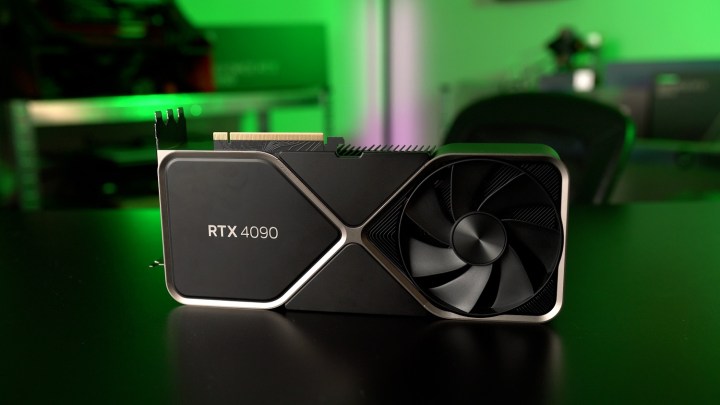
Jacob Roach / Digital Trends
Nvidia GeForce RTX 4090
The best graphics card for video editing
Pros
- Huge leaps in 4K gaming performance
- Excellent ray tracing performance
- High power and thermals, but manageable
- DLSS 3 performance is off the charts
Cons
- Very expensive
- DLSS 3 image quality needs some work
Why should you buy this: It’s the most powerful graphics card you can buy today, hands down.
Who’s it for: High-end enthusiasts that want the best of the best regardless of price.
What we thought of the Nvidia GeForce RTX 4090:
The RTX 4090 is a nonsense graphics card, and we mean that in the best way possible. It’s $1,600, which is hard to justify spending on any graphics card. But if you want the best of the best, the RTX 4090 is it, and by a significant margin.
The previous GPU champion, the RTX 3090 Ti, looks puny by comparison. Based on our testing, the RTX 4090 is nearly 70% faster than the RTX 3090 Ti, and almost 90% faster than the RTX 3090. It’s a 4K graphics card that enables features like ray tracing in the most demanding games available today.
It’s overkill for most people, and it comes with some high demands. You’ll need a power supply with a lot of wattage, and you’ll need a case to accommodate the card’s massive size. It’s a reasonable trade-off for high-end enthusiasts, though, especially with features like DLSS 3 on offer.

Nvidia GeForce RTX 4090
The best graphics card for video editing

Jacob Roach / Digital Trends
AMD Radeon RX 7900 XT
The best graphics card for VR
Pros
- DisplayPort 2.1 support
- Powerful 4K gaming
- Relatively small
Cons
- Disappointing generational improvements
- Loud and hot
Why should you buy this: It’s a powerful 4K GPU, and it supports DisplayPort 2.1 for high-end VR headsets.
Who’s it for: VR enthusiasts who want to drive high-end headsets.
What we thought of the AMD Radeon RX 7900 XT:
The AMD RX 7900 XT isn’t the best graphics card on the market, but it’s the best choice for VR. The main reason why is support for DisplayPort 2.1. High-end VR headsets require a ton of bandwidth, and DisplayPort 2.1 is the only connection standard that can deliver.
Although the RX 7900 XT doesn’t pose a great value, it’s no slouch of a GPU. Even at the high resolutions demanded by VR, it can deliver solid frame rates. It’s even faster than Nvidia’s RTX 4070 Ti, all while costing around the same price.
Even better, you can find it readily available at online retailers. Popular graphics cards still sell out immediately, but the RX 7900 XT is available at list price basically everywhere. It’s great for VR, but you can also leverage it for 4K gaming on a typical monitor.

AMD Radeon RX 7900 XT
The best graphics card for VR
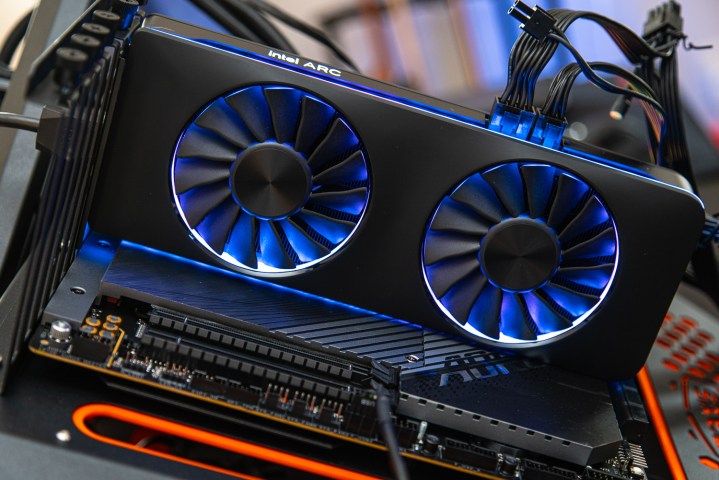
Jacob Roach / Digital Trends
Intel Arc A750
The best graphics card for the money
Pros
- Great 1080p and 1440p gaming performance
- Competitive ray tracing performance
- Relatively inexpensive
Cons
- Resizable BAR is necessary
- XeSS needs some work
Why should you buy this: It’s a great graphics card for the price, minus a few bugs.
Who’s it for: Gamers looking for a great deal that don’t mind dealing with a few bugs.
What we thought of the Intel Arc A750:
Intel’s Arc A750 has gotten much better since launch, now sporting solid DirectX 9 support and much faster drivers. It has always been competitive with Nvidia’s RTX 3060 while costing around $100 less, but it looks even more enticing now that Intel has slashed the A750’s price to $250.
AMD usually is the budget alternative to Nvidia, and although that’s still true, Nvidia has been the way to go if you want to turn on ray tracing. The Arc A750 has competitive ray tracing, unlike its AMD counterparts, meaning it can truly go toe-to-toe with the RTX 3060.
On top of that, the card also supports Intel’s XeSS upscaling feature, which uses AI to upscale your games and improve performance. It’s not available in a ton of games, but Intel should add support in more titles over the coming months.

Intel Arc A750
The best graphics card for the money
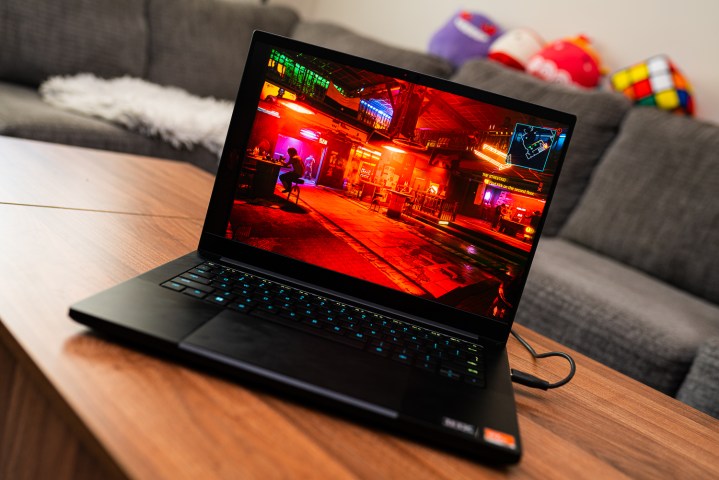
Jacob Roach / Digital Trends / Digital Trends
Nvidia GeForce RTX 4070 mobile
The best graphics card for laptops
Pros
- Available in a ton of laptops
- DLSS 3.5 support
- Efficient enough for thin and light machines
Cons
- A little expensive
- Struggles at 4K
Why should you buy this: It’s the sweet spot of Nvidia’s current mobile lineup of GPUs.
Who’s it for: Gamers on the go that need the perfect balance of power.
What we thought of the Nvidia GeForce RTX 4070 mobile:
If you want the ultimate mobile gaming experience, it’s hard to beat the RTX 4070 mobile. It’s not the fastest laptop graphics card Nvidia currently offers, but it’s by far the best. It’s available in a massive number of laptops, including the Lenovo Legion Pro 5 and Razer Blade 14, and all of them offer great performance at a 1440p resolution.
What’s most impressive about the RTX 4070 mobile, however, is that it’s scalable. You can pump it with power in a large, 16-inch laptop for a small performance boost, but the efficiency of the GPU means it has a home in thinner machines like the Asus ROG Zephyrus G14.
It also has access to DLSS 3.5, making things like ray tracing possible on a laptop. You won’t find the RTX 4070 available in more budget-focused machines, but if you have the cash to spare, it definitely strikes the perfect balance of efficiency and power for a laptop.

Nvidia GeForce RTX 4070 mobile
The best graphics card for laptops

Jacob Roach / Digital Trends
Nvidia GeForce RTX 4070 Ti
The best graphics card with DLSS 3
Pros
- DLSS 3
- Excellent thermal performance
- Solid value at 1440p and 1080p
Cons
- Poor performance at 4K
- Will likely sell above list price
Why should you buy this: It’s the cheapest option of Nvidia’s current generation, and it supports DLSS 3
Who’s it for: Gamers who want flagship performance but don’t have an unlimited budget.
What we thought of the Nvidia GeForce RTX 4070 Ti:
The RTX 4070 Ti isn’t a perfect graphics card. It’s very expensive at $900, and it’s beaten by cheaper current and last-gen options from AMD. However, it still delivers high-end 4K gaming performance and comes with the key feature of Nvidia’s RTX 40-series graphics cards: DLSS 3.
DLSS 3 adds DLSS Frame Generation, allowing you to massively improve your frame rate in games like Atomic Heart, Cyberpunk 2077, and, Warhammer 40:000: Darktide. It’s exclusive to Nvidia’s most recent generation, and although DLSS 3 isn’t available in every game, it’s a selling point in the few demanding titles that feature the tech.
In standard performance, the RTX 4070 Ti delivers 4K gaming performance on the level of last-gen flagships, narrowly beating out cards like the RTX 3090. It’s still a very powerful GPU, even if it’s a bit expensive for the current generation. The good news is that prices are dropping, with some models available for around $850.

Nvidia GeForce RTX 4070 Ti
The best graphics card with DLSS 3
Frequently Asked Questions
How much should you spend on a graphics card?
As a rule of thumb, you should dedicate about 30% of your budget to a graphics card for a gaming PC. For 1080p, you should spend around $300 to $400; for 1440p, around $400 to $500; and for 4K, $600 or above. The Radeon RX 6600 XT targets 1080p at $379, the GeForce RTX 3070 is great for 1440p at $500, and the GeForce RTX 3080 is the perfect video card for 4K at $700.
Graphics cards are vastly overpriced in 2022, though. As it stands now, you can expect to pay double what you should for each resolution. Hopefully, that will change in the coming months.
How can you find the right power supply for a graphics card?
Nvidia and AMD recommend power supply wattage for their most recent graphics card. The Radeon RX 6800 XT, for example, draws 300W of power and AMD recommends a 750W PSU at least. Similarly, the GeForce RTX 3080 video card draws 320W and Nvidia recommends a 750W PSU. These recommendations aren’t always perfect, though, so we recommend using a PSU calculator.
How do you know which graphics card will best suit your needs?
Finding the graphics card that will best suit your needs comes down to the resolution of your display and the kinds of games you play. The Nvidia GeForce RTX 3080 is great for 4K, for example, but it’s overkill for 1080p where the AMD Radeon RX 6600 XT shines. The lower your display’s resolution, the less you need to spend on a graphics card.
Beyond that, consider the games you want to play and at what frame rates. You can use the Nvidia GeForce GTX 1660 Super for everything from Counter-Strike: Global Offensive to Borderlands 3, but you might need to step up to the GeForce RTX 3070 to play games like Assassin’s Creed Valhalla.
Editors’ Recommendations

